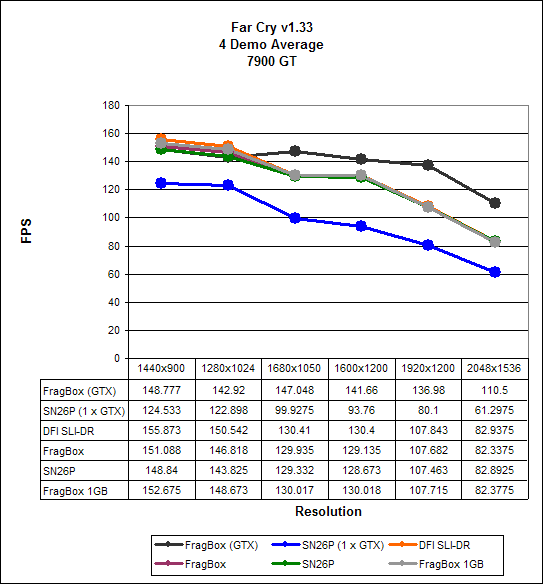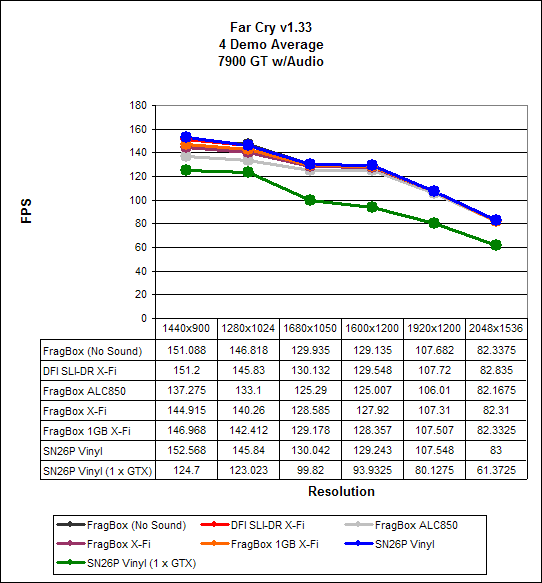Falcon Northwest FragBox SLI: Dare to Dream
by Jarred Walton on May 3, 2006 9:00 AM EST- Posted in
- Systems
Far Cry v1.33
Far Cry is easily the oldest of the titles I'm still using for benchmarks. Amazingly, the graphics quality still competes well against the latest games on the market. The rendering of a bright, tropical environment is certainly different from most other titles, and we're looking forward to seeing CryTek's Crisis game in the future. With Far Cry, we record average frame rates from three passes on the following Ubisoft demos: Regulator, Research, Training, and Volcano. We then average the results from these four maps to come up with a composite score. If you're interested in the level-specific results, we can provide those as well, but in order to avoid generating a ton of different graphs we averaged the results.


At lower resolutions, Far Cry is still CPU limited, though with frame rates in the mid-100s, you're not really losing much in the way of performance. As resolution increases, frame rates eventually begin to drop, but everything short of 2048x1536 is more than playable with a single GTX card. The systems are once again pretty close to each other, with the DFI system being a bit faster at lower resolutions, while the FragBox takes the lead by a small margin at higher resolutions. Far Cry is another game that clearly doesn't benefit from more than 1GB of RAM, though as with most games, loading times are noticeably faster.


Enabling sound in Far Cry doesn't cause nearly as much of a performance hit as in other games, although the FragBox scores do drop about 4%. On the other hand, the shuttle and DFI systems, as well as the FragBox X-Fi configuration, all show less than a 4% performance decrease. That typically means the bottleneck is something other than the CPU, or else the sound subsystem is simply not as CPU intensive as in other games.
Far Cry is easily the oldest of the titles I'm still using for benchmarks. Amazingly, the graphics quality still competes well against the latest games on the market. The rendering of a bright, tropical environment is certainly different from most other titles, and we're looking forward to seeing CryTek's Crisis game in the future. With Far Cry, we record average frame rates from three passes on the following Ubisoft demos: Regulator, Research, Training, and Volcano. We then average the results from these four maps to come up with a composite score. If you're interested in the level-specific results, we can provide those as well, but in order to avoid generating a ton of different graphs we averaged the results.


At lower resolutions, Far Cry is still CPU limited, though with frame rates in the mid-100s, you're not really losing much in the way of performance. As resolution increases, frame rates eventually begin to drop, but everything short of 2048x1536 is more than playable with a single GTX card. The systems are once again pretty close to each other, with the DFI system being a bit faster at lower resolutions, while the FragBox takes the lead by a small margin at higher resolutions. Far Cry is another game that clearly doesn't benefit from more than 1GB of RAM, though as with most games, loading times are noticeably faster.


Enabling sound in Far Cry doesn't cause nearly as much of a performance hit as in other games, although the FragBox scores do drop about 4%. On the other hand, the shuttle and DFI systems, as well as the FragBox X-Fi configuration, all show less than a 4% performance decrease. That typically means the bottleneck is something other than the CPU, or else the sound subsystem is simply not as CPU intensive as in other games.










32 Comments
View All Comments
segagenesis - Wednesday, May 3, 2006 - link
Obviously this wont be cheap, but what an interesting feat of engineering. For a SFF computer this should literally have flames shooting out the back.Gary Key - Wednesday, May 3, 2006 - link
If they had utilized a Pentium 955EE it would have had flames coming out from all directions. :) Just kidding, not really, but we found it amazing how well this case design took thermal requirements under consideration when utilizing SLI and a FX series processor.